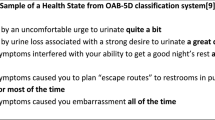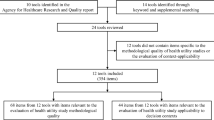Abstract
Generic preference-based measures (GPBMs) of health are used to obtain the quality adjustment weight required to calculate the quality-adjusted life year in health economic models. GPBMs have been developed to use across different interventions and medical conditions and typically consist of a self-complete patient questionnaire, a health state classification system, and preference weights for all states defined by the classification system. Of the six main GPBMs, the three most frequently used are the Health Utilities Index version 3, the EuroQol 5 dimensions (3 and 5 levels), and the Short Form 6 dimensions. There are considerable differences in GPBMs in terms of the content and size of descriptive systems (i.e. the numbers of dimensions of health and levels of severity within these), the methods of valuation [e.g. time trade-off (TTO), standard gamble (SG)], and the populations (e.g. general population, patients) used to value the health states within the descriptive systems. Although GPBMs are anchored at 1 (full health) and 0 (dead), they produce different health state utility values when completed by the same patient. Considerations when selecting a measure for use in a clinical trial include practicality, reliability, validity and responsiveness. Requirements of reimbursement agencies may impose additional restrictions on suitable measures for use in economic evaluations, such as the valuation technique (TTO, SG) or the source of values (general public vs. patients).
Similar content being viewed by others
References
Rowen D, Azzabi Zouraq I, Chevrou-Severac H, van Hout B. International Regulations and Recommendations for Utility Data for Health Technology Assessment. PharmacoEconomics. doi: 10.1007/s40273-017-0544-y
Kaplan RM, Anderson JP. A general health policy model: update and application. Health Serv Res. 1988;23:203–35.
Feeny DH, Furlong WJ, Torrance GW, Goldsmith CH, Zenglong Z, Depauw S, Denton M, Boyle M. Multiattribute and single-attribute utility function: the Health Utility Index Mark 3 system. Med Care. 2002;40:113–28.
Brooks R. EuroQol: the current state of play. Health Policy. 1996;37(1):53–72.
Herdman M, Gudex C, Lloyd A, Janssen M, Kind P, Parkin D, et al. Development and preliminary testing of the new five-level version of EQ-5D (EQ-5D-5L). Qual Life Res. 2011;20(10):1727–36.
Brazier J, Roberts J, Deverill M. The estimation of a preference-based single index measure for health from the SF-36. J Health Econ. 2002;21:271–92.
Brazier JE, Roberts J. Estimating a preference-based index from the SF-12. Med Care. 2004;42:851–9.
Richardson J, Sinha K, Iezzi A, Khan MA. Modelling utility weights for the Assessment of Quality of Life (AQoL) 8D. Qual Life Res. 2014;23:2395–404. doi:10.1007/s11136-014-0686-8.
Brazier J, Ratcliffe J, Tsuchiya A, Solomon J. Measuring and valuing health for economic evaluation. 2nd ed. Oxford: Oxford University Press; 2017. p. 175–256.
Richardson J, McKie J, Bariola E. Multiattribute utility instruments and their use. In: Culyer AJ, editor. Encyclopaedia of health economics, vol. 2. San Diego: Elsevier; 2014. p. 341–57.
NICE (National Institute for Health and Care Excellence). Guide to the methods of technology appraisal. London: National Health Service, 2008. (Replaced by the 2013 version). Available from www.nice.org.uk. Accessed 11 Sept 2016.
NICE (National Institute for Health and Care Excellence). Guide to the methods of technology appraisal. London: National Health Service, 2013. Available from www.nice.org.uk. Accessed 11 Sept 2016.
Bansback N, Brazier J, Tsuchiya A, et al. Using a discrete choice experiment to estimate health state utility values. J Health Econ. 2012;31:306–18.
Bansback N, Hole AR, Mulhern B, et al. Testing a discrete choice experiment including duration to value health states for large descriptive systems: addressing design and sampling issues. Soc Sci Med. 2014;114:38–48.
Mulhern B, Bansback N, Brazier J, et al. Preparatory study for the revaluation of the EQ-5D tariff: methodology report. Health Technol Assess 2014;18:vii–xxvi, 1–191.
Norman R, Cronin P, Viney R. A pilot discrete choice experiment to explore preferences for EQ-5D-5L health states. Appl Health Econ Health Policy. 2013;11:287–98.
Norman R, Viney R, Brazier J, et al. Valuing SF-6D health states using a discrete choice experiment. Med Decis Making. 2014;34:773–86.
Viney R, Norman R, Brazier J, et al. An Australian discrete choice experiment to value EQ-5D health states. Health Econ. 2014;23:729–42.
Devlin N, Shah KK, Feng Y et al. Valuing Health-Related Quality of Life: An EQ-5D-5L Value Set for England. Discussion Paper. HEDS Discussion Paper Series (16.02). Health Economics and Decision Science, School of Health and Related Research (ScHARR), University of Sheffield, Sheffield; 2016. http://eprints.whiterose.ac.uk/97964/. Accessed 3 Sept 2016.
Brazier JE, Rice N, Roberts J. Modelling health state valuation data. In: Murray C, Salomon J, Mathers C, Lopez A, Lozano R, editors. Summary measures of population health: concepts, ethics, measurement and applications. Geneva: World Health Organization; 2002. p. 529–48.
Kharroubi SA, O’Hagan A, Brazier JE. Estimating utilities from individual health preference data: a nonparametric Bayesian method. Appl Stat. 2005;54:879–95.
Mendez I, Abellán JM, Sánchez FI, Martínez JE. Inverse probability weighted estimation of social tariffs: an illustration using SF-6D value sets. J Health Econ. 2011;30(1280–1292):2011.
Rowen D, Brazier J, Van Hout B. A comparison of methods for converting DCE values onto the full health-dead QALY scale. Med Decis Making. 2015;35(3):328–40.
Available from http://www.euroqol.org/. Accessed 15 Feb 2017
Szende A, Oppe M, Devlin N, editors. EQ-5D value sets: inventory, comparative review and user guide. vol. 2. Springer Science & Business Media: Netherlands; 2007.
Dolan P. Modeling valuations for EuroQol health states. Med Care. 1997;35(11):1095–108.
Barton GR, Bankart J, Davis AC, Summerfield QA. Comparing utility scores before and after hearing-aid provision: results according to the EQ-5D, HUI3 and SF-6D. Appl Health Econ Health Policy. 2004;3(2):103–5.
Espallargues M, Czoski-Murray CJ, Bansback NJ, Carlton J, Lewis GM, Hughes LA, et al. The impact of age-related macular degeneration on health status utility values. Invest Ophthalmol Vis Sci. 2005;46(11):4016–23.
Finch AP, Brazier J, Mukuria CW. Validity and responsiveness of preference based measures: a critical overview of reviews. Value Health. 2015;18(7):A744.
Streiner DL, Norman GR, Cairney J. Health measurement scales: a practical guide to their development and use. 5th ed. Oxford: Oxford University Press; 2014.
Preamble to the Constitution of WHO as adopted by the International Health Conference, New York, 19 June–22 July 1946—see http://www.who.int/suggestions/faq/en/. Accessed 11 Sept 2016.
Schipper H, Clinch J, Olweny C. Quality of life studies: definitions and conceptual issues. In: Spilker B, editor. Quality of life and pharmoeconomics in clinical trials. Philadelphia: Lippincott-Raven Publishers; 1996.
Longworth L, Yang Y, Young T, Mulhern B, Hernandez Alava M, Mukuria C, et al. Use of generic and condition-specific measures of health-related quality of life in NICE decision-making: a systematic review, statistical modelling and survey. Health Technol Assess. 2014;18(9):1–224.
Moock J, Kohlmann T. Comparing preference-based quality-of-life measures: results from rehabilitation patients with musculoskeletal, cardiovascular, or psychosomatic disorders. Qual Life Res. 2008;17(3):485–95.
Brazier J, Connell J, O’Cathain A. Do EQ-5D and SF-6D ask the right questions in mental health? A content validation using interviews with patients. Value Health. 2014;17(3):A194.
Hounsome N, Orrell M, Edwards RT. EQ-5D as a quality of life measure in people with dementia and their carers: evidence and key issues. Value Health. 2011;14(2):390–9.
Harper R, Brazier JE, Waterhouse JC, Walters SJ, Jones NM, Howard P. Comparison of outcome measures for patients with chronic obstructive pulmonary disease (COPD) in an outpatient setting. Thorax. 1997;52(10):879–87.
Burton M, Walters SJ, Saleh M, Brazier JE. An evaluation of patient-reported outcome measures in lower limb reconstruction surgery. Qual Life Res. 2012;21(10):1731–43.
Conner-Spady B, Suarez-Almazor ME. A comparison of preference-based health status tools in patients with musculoskeletal disease. In: 18th Plenary Meeting of the EuroQol Group. 2001. p. 235–245.
Longworth L, Bryan S. An empirical comparison of EQ-5D and SF-6D in liver transplant patients. Health Econ. 2003;12(12):1061–7.
Guidelines for pharmacoeconomic research: evaluation and actualisation. Diemen: CVZ, 2006. Available from: College voor zorgverzekeringen, http://www.cvz.nl/. Accessed 6th Sept 2016.
Wisloff T, Hagen G, Hamidi V, Movik E, Klemp M, Olsen JA. Estimating QALY gains in applied studies: a review of cost-utility analyses published in 2010. Pharmacoeconomics. 2014;32(4):367–75.
http://www.euroqol.org/about-eq-5d/valuation-of-eq-5d/eq-5d-5l-value-sets.html. Accessed 20 Feb 2017.
Cella D, Gershon R, Lai JS, et al. Qual Life Res. 2007;16(Suppl 1):133. doi:10.1007/s11136-007-9204-6.
Craig BM, Reeve BB, Brown PM, Cella D, Hays RD, Lipscomb J. A. Simon Pickard, Dennis A. Revicki. US valuation of health outcomes measured using the PROMIS-29. Value Health. 2014;17(8):846–53.
Sintonen H. The 15D instrument of health-related quality of life: properties and applications. Ann Med. 2001;33(5):328–36.
Acknowledgements
The authors would like to thank Prof. Jon Karnon, PhD, of the University of Adelaide and Dr. Andrew Lloyd, PhD, of Bladen Associates Ltd for their editorial review.
Author information
Authors and Affiliations
Contributions
JEB reviewed the literature and wrote the first draft of the manuscript. RA made significant edits to the first and subsequent drafts of the manuscript. DR made significant edits to the first and subsequent drafts of the manuscript. HCS made significant edits to the first and subsequent drafts of the manuscript.
Corresponding author
Ethics declarations
Funding
This study was funded by an unrestricted grant from Takeda Pharmaceuticals International AG.
Conflict of interest
Helene Chevrou-Severac is employed by Takeda. Roberta Ara has no conflicts of interest. Donna Rowen has no conflicts of interest. John Brazier is a member of the EuroQol Group Executive Committee and a developer of the SF-6D, for which commercial users pay a licence fee to the University of Sheffield.
Disclosure statement
This article is published in a special edition journal supplement wholly funded by Takeda Pharmaceuticals International AG, Zurich, Switzerland.
Rights and permissions
About this article
Cite this article
Brazier, J., Ara, R., Rowen, D. et al. A Review of Generic Preference-Based Measures for Use in Cost-Effectiveness Models. PharmacoEconomics 35 (Suppl 1), 21–31 (2017). https://doi.org/10.1007/s40273-017-0545-x
Published:
Issue Date:
DOI: https://doi.org/10.1007/s40273-017-0545-x




